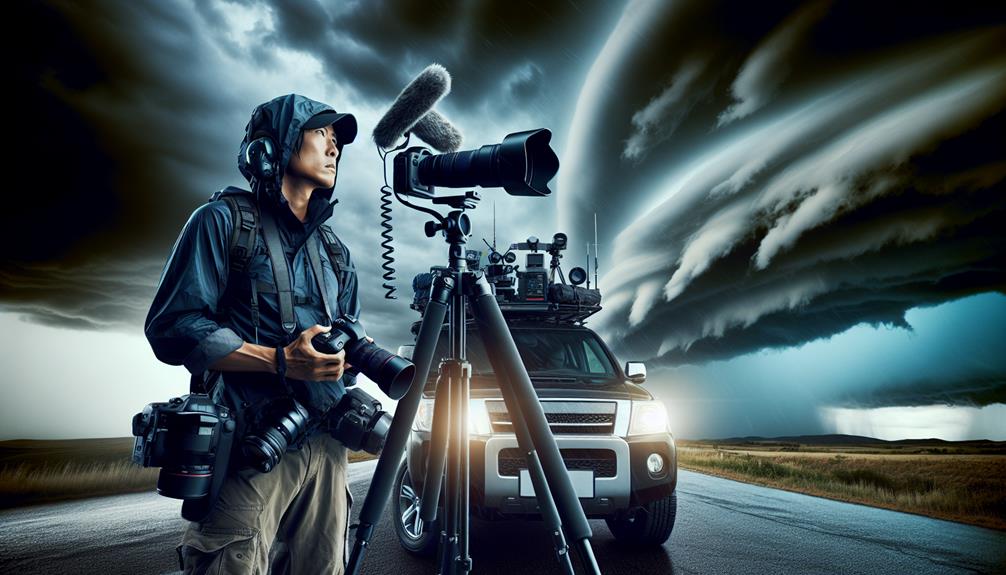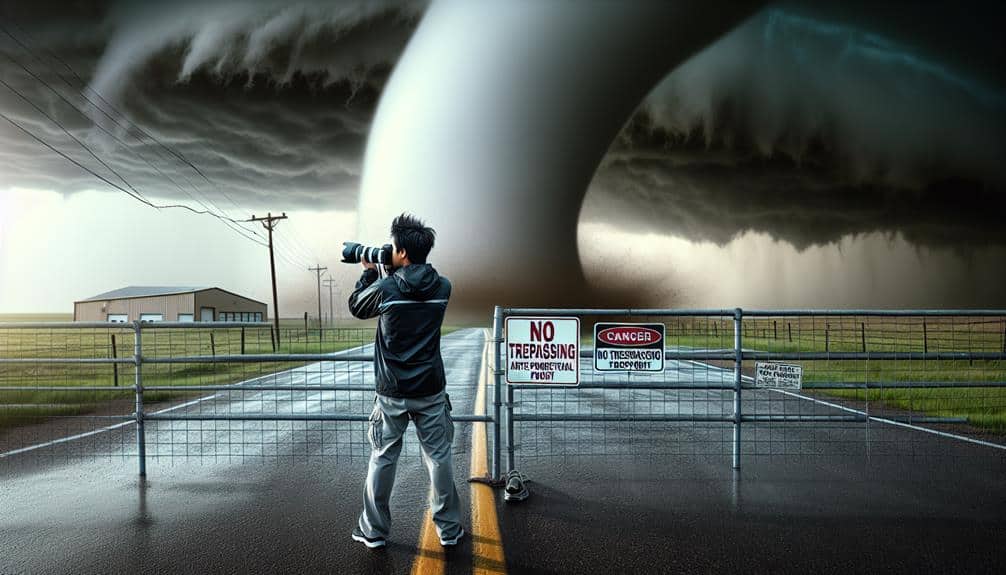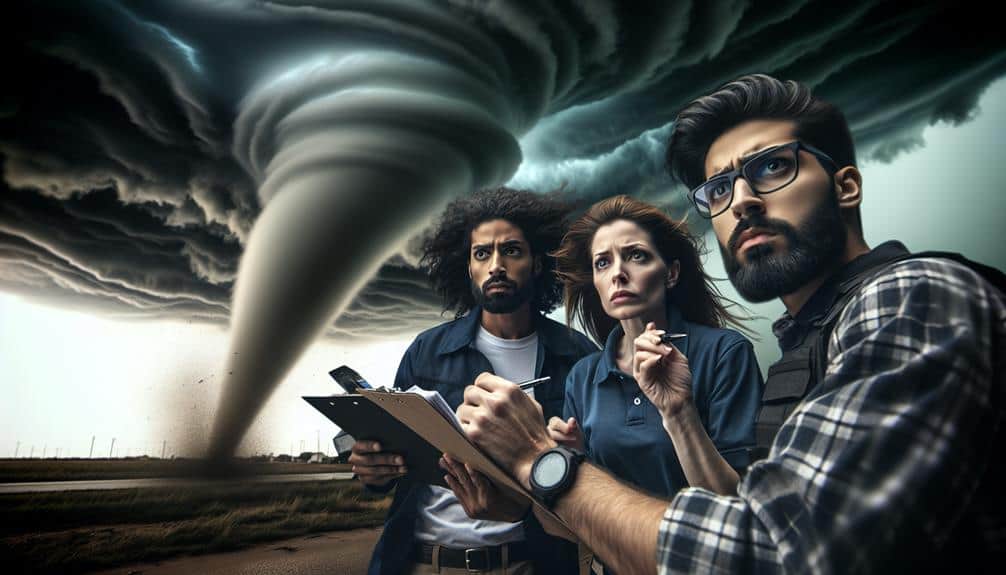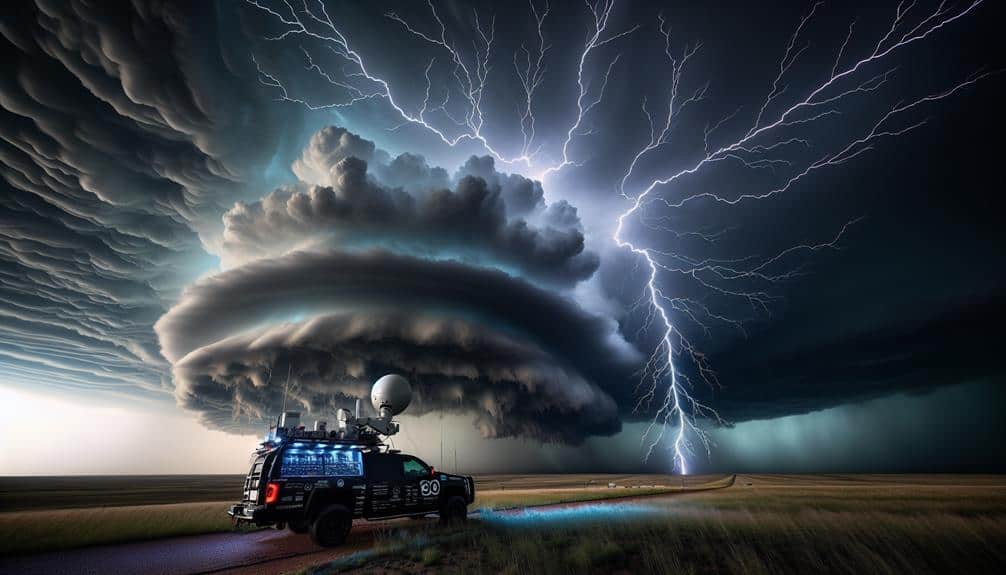We prioritize public safety by implementing thorough risk evaluations and community outreach. Utilizing dependable meteorological data and advanced forecasting models, we stay ahead of potential hazards. Equipped with portable Doppler radars and GPS systems, our gear undergoes regular inspections. Collaborating with authorities guarantees streamlined decision-making and safety. Sharing real-time updates through live streaming and interactive maps keeps everyone informed. We respect private property and avoid sensationalism by fact-checking and sourcing trustworthy information. Promoting safe practices and fostering teamwork are essential. These approaches guarantee efficient storm chasing while keeping communities safe. Explore further to uncover detailed strategies.
Key Points
- Accurately evaluate and communicate potential hazards of severe weather events to prioritize public safety.
- Collaborate with local emergency services and authorities for mutual safety and updated information.
- Utilize reliable meteorological data and advanced forecasting tools for informed decision-making.
- Share real-time updates through live streaming and social media to keep everyone informed.
Prioritize Public Safety
We must always prioritize public safety by accurately evaluating and communicating the potential hazards of severe weather events. To achieve this, we need robust risk assessment strategies that identify the severity and impact of impending storms. This involves analyzing meteorological data and modeling potential outcomes to anticipate threats accurately.
Once we've a clear understanding of the risks, it's crucial to implement effective communication strategies to inform the public promptly and clearly.
Community outreach plays a pivotal role in disseminating this important information. By engaging with local communities, we ensure that everyone is aware of the potential dangers and understands the necessary emergency protocols. This outreach can take various forms, including social media updates, local news broadcasts, and community meetings. Each method aims to reach as many people as possible, ensuring no one is left uninformed.
Emergency protocols should be well-defined and regularly updated to reflect the latest best practices. These protocols include evacuation routes, shelter locations, and safety procedures. By maintaining clear and actionable emergency plans, we empower individuals to make informed decisions that protect their freedom and safety.
Effective risk assessment and communication strategies are vital for safeguarding our communities in the face of severe weather events.
Conduct Thorough Research
To guarantee our safety while storm chasing, we must conduct thorough research.
We'll need to understand weather patterns, study tornado formation, and analyze historical data.
This approach helps us make informed decisions and anticipate potential hazards.
Understand Weather Patterns
Understanding weather patterns requires conducting in-depth research using reliable meteorological data and advanced forecasting models. We must tap into extensive weather forecasting tools and storm tracking systems to predict severe weather events accurately. By leveraging these technologies, we gain invaluable insights into the atmospheric conditions that precede storms, thunderstorms, and other severe weather phenomena.
Climate analysis is vital for understanding long-term weather trends and their impact on storm formation. By examining historical data, we can identify patterns that may indicate future weather behaviors. This allows us to plan our storm-chasing endeavors more effectively, ensuring we're in the right place at the right time while maintaining safety.
Wind patterns play a significant role in predicting storm movements and intensities. By analyzing both surface winds and upper-level winds, we can determine the likely path and strength of a storm. This information is essential for making real-time decisions while out in the field, helping us to avoid hazardous situations and optimize our observation points.
Study Tornado Formation
Analyzing the intricate dynamics of tornado formation involves delving into the complex interactions between atmospheric instability, wind shear, and moisture content. We need to understand how these elements interact to generate the supercell thunderstorms that can spawn tornadoes. Tornado dynamics are influenced by the vertical wind shear, which is the change in wind speed and direction with height, creating the rotation needed for a tornado to develop.
Our storm chasing techniques must be rooted in thorough research. We should examine how convective available potential energy (CAPE) indicates atmospheric instability, providing insight into the likelihood of severe weather. By monitoring dew points and moisture content, we can gauge the fuel available for storm development. Additionally, understanding the role of boundary layers, such as drylines and frontal boundaries, helps us predict where tornadoes are likely to form.
We can't underestimate the importance of real-time data from Doppler radar and satellite imagery, which offer critical insights into storm structures and rotation. By integrating these data points, we enhance our ability to anticipate tornado genesis and improve our storm chasing strategies. This meticulous research is essential for both our safety and the effectiveness of our engagements.
Analyze Historical Data
Building on our understanding of tornado formation, we must now focus on analyzing historical data to identify patterns and improve our predictive models. By scrutinizing past weather events, we can uncover critical insights that inform our storm chasing strategies.
Data analysis allows us to pinpoint recurring weather trends, enhancing our ability to anticipate tornado occurrences with greater precision.
We should start by compiling extensive datasets from meteorological archives, which include parameters such as wind speeds, pressure systems, and temperature gradients. Utilizing advanced statistical tools, we can then correlate these variables with historical tornado events. This meticulous approach enables us to reveal subtle patterns that might otherwise go unnoticed.
Moreover, leveraging machine learning algorithms can greatly enhance our predictive capabilities. By training models on historical data, these algorithms can recognize complex relationships between atmospheric conditions and tornado formation. This fusion of historical data analysis and modern technology ensures that our predictions aren't only data-driven but also dynamically adaptive.
Ultimately, a thorough examination of past weather trends empowers us to make more informed decisions in the field. By understanding the nuances of historical tornado activity, we can better safeguard ourselves while maintaining the freedom to chase storms safely and efficiently.
Use Reliable Equipment

Dependable equipment is necessary for maintaining both safety and accuracy during storm chasing expeditions. We can't emphasize enough the significance of regular equipment maintenance. Keeping our gear in prime condition helps us adhere to safety protocols and minimizes the risk of malfunction during pivotal moments. Each device, whether it's a high-resolution camera or an anemometer, needs to be inspected and tested before every chase.
With technology advancements, we've access to more sophisticated tools that enhance our ability to predict and monitor storm patterns. These devices, including portable Doppler radars and GPS systems, offer us real-time data essential for making informed decisions. However, this technology also requires us to stay updated with the latest software and firmware to avoid any performance issues.
Emergency preparedness is another key aspect of using reliable equipment. We should always carry backup batteries, chargers, and even secondary devices to ensure continuous operation in the field. A well-stocked emergency kit, including first aid supplies and communication tools, is indispensable.
Partner With Authorities
Collaborating with local authorities and meteorological agencies enhances our ability to respond swiftly and efficiently to rapidly changing storm conditions. By establishing and maintaining relationships with authorities, we guarantee that our storm chasing activities are both safe and effective.
To achieve this, we need to:
- Collaborate with local emergency services: This includes sharing our plans and locations to ensure mutual safety and preparedness.
- Communicate with authorities regularly: Keeping an open line of communication enables us to stay informed about any emergency advisories and road conditions.
- Establish protocols for coordination: Clear protocols help streamline information sharing and decision-making processes during storm events.

Sharing real-time updates guarantees that all team members and associated authorities stay informed and can make prompt decisions during storm chasing activities. By utilizing live streaming, we can broadcast our findings directly from the field, providing immediate visual data on storm developments. This secures that everyone, from team members to emergency services, has access to the latest conditions.
Interactive maps are another essential tool. They allow us to geo-tag specific locations, mark severe weather patterns, and track storm movements dynamically. This real-time mapping secures everyone knows the exact positioning and trajectory of the storm, aiding in swift decision-making and route planning.
Social media platforms are indispensable for community engagement. By posting timely updates and videos, we not only inform the public but also gather valuable on-the-ground reports from community members. This two-way communication can be vital for verifying storm paths and impacts, adding another layer of accuracy to our data.
Educate the Community
With real-time updates making certain everyone stays informed, we must also focus on educating the community about storm safety practices and preparedness strategies. It's vital we empower our community to understand the risks and how to respond effectively.
One of the best ways to do this is through community workshops, which promote safety awareness by providing hands-on training and detailed information.
To further our mission, we can organize school presentations that engage students and staff in emergency preparedness. These presentations can cover the basics of storm identification, safe shelter locations, and essential survival tips. When we educate the youth, we instill a culture of safety that they can carry forward into adulthood.
Here's how we can engage the community effectively:
- Community workshops: Offer practical demonstrations on using emergency equipment and first aid.
- Safety awareness campaigns: Distribute informative materials through local media and social networks.
- School presentations: Teach students about storm patterns, warning signs, and emergency protocols.
Respect Private Property

Respecting private property is fundamental to maintaining trust and cooperation within the communities we serve. When we're out chasing storms, it's easy to get caught up in the excitement and overlook property boundaries. However, adhering to ethical boundaries is crucial. By respecting private property, we demonstrate our commitment to being responsible and considerate members of the communities we engage with.
Trespassing risks aren't just about potential confrontations with landowners; they also involve serious legal consequences. Entering private property without permission can lead to fines, lawsuits, and even arrest. These legal repercussions not only tarnish our reputation but also jeopardize future storm-chasing opportunities. Hence, it's essential to always seek permission before entering private land.
Furthermore, respecting property boundaries helps to protect the land and resources of the community. Driving over fields, cutting through fences, or damaging property can have lasting, detrimental impacts. Our actions should reflect our respect for the environment and the people living in it. By maintaining these ethical boundaries, we foster goodwill and ensure that our presence is seen as beneficial rather than disruptive.
Let's prioritize respect and legality in all our storm-chasing endeavors.
Avoid Sensationalism
Our dedication to avoiding sensationalism guarantees we provide accurate, responsible information during storm-chasing activities. By focusing on ethical reporting, we guarantee that the public receives truthful, unembellished accounts of storm events. Sensationalism can mislead, creating unnecessary panic or false expectations. Our approach to responsible journalism is paramount.
To uphold these standards, we adhere to the following principles:
- Fact-Checking: We rigorously verify all data before dissemination.
- Objective Reporting: We present information without exaggeration or bias.
- Source Verification: We rely on credible sources and cross-reference information.
Ethical reporting is our cornerstone, ensuring that we don't compromise the truth for dramatic effect. Our audience values freedom, and access to accurate information empowers them to make informed decisions.
We avoid using hyperbolic language and focus on delivering clear, concise, and factual updates. Additionally, we prioritize the integrity of our reports, which fosters trust and reliability.
Promote Safe Practices

We prioritize the implementation of proven safety measures to guarantee the well-being of all participants during storm-chasing activities. Our focus on safety protocols ensures that every chase is conducted with a thorough understanding of potential hazards.
Preparation begins well before the chase with rigorous risk assessment, identifying both environmental threats and logistical challenges. By analyzing weather patterns and geographical data, we can anticipate storm behavior and plan our routes accordingly.
Community involvement is a cornerstone of our approach. Engaging with local authorities, meteorologists, and fellow storm chasers allows us to share essential information and resources. This collaborative effort enhances our situational awareness and provides a support network in case of emergencies.
We make it a point to communicate our plans and updates, fostering a culture of mutual respect and shared responsibility.
In terms of preparedness, we equip our teams with necessary tools such as first aid kits, communication devices, and emergency supplies. Regular drills and training sessions ensure that everyone is familiar with safety procedures and can react swiftly if conditions deteriorate.
Our commitment to these practices not only safeguards our teams but also sets a high standard for the entire storm-chasing community.
Foster Team Collaboration
Building on our dedication to safety, fostering team collaboration is essential to guarantee seamless communication and coordinated efforts during storm-chasing activities. Effective team dynamics are vital for making real-time decisions and making sure all members are aligned with our objectives. We need to establish robust communication strategies that allow us to share information quickly and accurately.
To enhance our collaboration, we must focus on several key areas:
- Trust building: Create an environment where every team member feels valued and confident in their role. Trust allows us to rely on each other, especially when conditions become unpredictable.
- Effective communication strategies: Use tools and protocols that facilitate clear and concise communication. This includes predefined signals, regular check-ins, and utilizing technology to stay connected.
- Conflict resolution: Address disagreements promptly and constructively. Having a predefined conflict resolution process helps maintain focus and cohesion within the team.
Frequently Asked Questions
What Are the Signs of an Impending Tornado?
We should watch for tornado warning signs like dark, greenish skies, large hail, and a rotating, low-hanging cloud base. Understanding the tornado formation process helps identify these signs and guarantees we're prepared for action.
How Can I Identify Safe Locations While Storm Chasing?
Think of storm chasing like finding your way through a maze; every turn requires foresight. We pinpoint safe shelters and evacuation routes, establish an emergency communication plan, and constantly monitor weather. This guarantees we're always ready for swift action.
What Are the Common Mistakes to Avoid During Storm Chasing?
When storm chasing, we often make common mistakes like neglecting safety protocols and skipping thorough risk assessments. Let's always make sure we follow proper procedures and continuously evaluate risks to enjoy our freedom safely and responsibly.
How Should I Prepare My Vehicle for Storm Chasing?
We should prioritize vehicle maintenance and stock up on safety equipment. Pack essential emergency supplies, and guarantee reliable communication devices. This preparation maximizes our safety and freedom while chasing storms.
What Apps or Tools Are Best for Tracking Storms in Real-Time?
We rely on storm tracking apps like RadarScope and Storm Shield for real-time storm updates and safety alerts. These tools provide GPS tracking, ensuring we stay informed and safe while enjoying the freedom of storm chasing.


